parking brake BUICK PARK AVENUE 1998 Owners Manual
[x] Cancel search | Manufacturer: BUICK, Model Year: 1998, Model line: PARK AVENUE, Model: BUICK PARK AVENUE 1998Pages: 426, PDF Size: 23.59 MB
Page 87 of 426
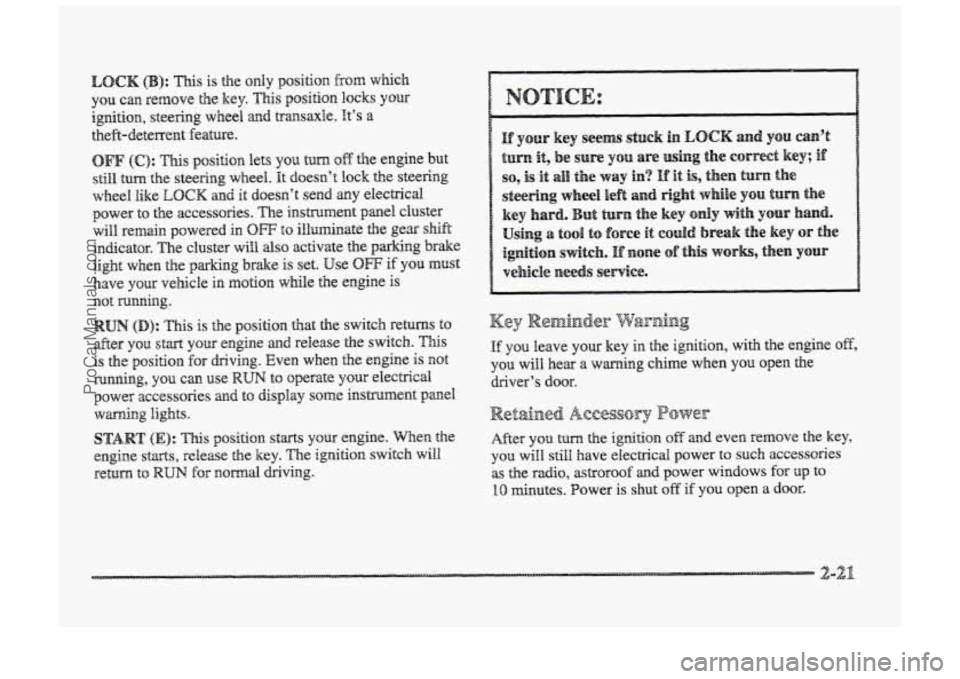
I
LOCK @I: This is the only position from which
YOU can remove the key. This position locks YOU
igition, steering wheel and transaxle. It’s a
theft-deterrent feature.
OFF (C): This position lets YOU turn ofif the engine but
still turn the steering wheel. It doesn’t lock the steering
wrlhee1 like LOCK and it doesn’t send my electrical
power to
the accessories. The instrument panel cluster
will remain powered in OFF to illarminate the gear sWt
indicator. The cluster will also activate the parking brake
fight when the parking brake is set. Use OW if you must
have your vehicle in motion while the engine is
not mnanaing.
RUN (D): This is the position that the switch returns to
after you start YSUP engine and release the switch. This
is &e p~sisi~n for driving. Even when the engine is not
running, you can use RUN to operate your electrical
power accessories anad t~ display some instrument panel
START (E): This position starts your engine. When the
engine
starts, release the key. The ignition switch will
return to RUN for ~a~rrrnal driving.
wdng
lights.
Retained Acces§ory Power
After you turn the ignition off md even remove the key,
you
will still have electrical power to such accessories
as the radio, astroroof ad power windows for up to
10 minutes. Power is shut off if you open a door.
2-21
ProCarManuals.com
Page 90 of 426
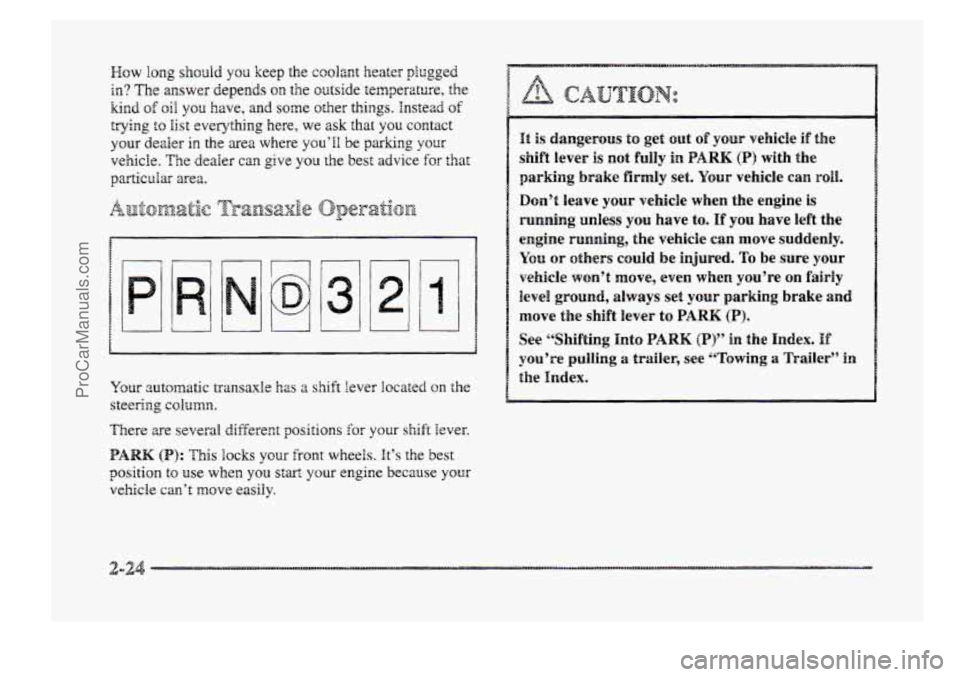
Wow long shodd YOU keep the coolant heater plugged
in? The answer depends on the outside temperature, the
kind of oil you have, and some other things. Instead of
trying t~ list everything here, we ask that you contact
your
dealer in the area where you’ll be parking pur
vehicle. The dealer cm give you the best advice for that
particdar area.
Y0mr automatic transaxle has a shift lever located on the
steering column.
There we several different positions for your shift lever.
PARK (PI: This Bocks your front wheels. It’s the best
position t~ we when YOU start your engine because pl~r
vehicle can’t move easily.
CAUTION:
I& is dangerous to get out of your vehick if the
shift lever is not fully in PARK (P) with the
parking brake firmly set.
Your vehicle can roll.
Don’t leave your vehicle when the engine is
running unless you have to. If you have left the
engine running, the vehicle can move suddenly.
You or others could be injured. TQ be sure your
vehicle won’t move, even when you’re on fairly
level ground, always set
y0w parking brake and
move the shift lever to PARK (P).
See ‘“Shifting Hnt~ PARK (P)” in the Index. If
you’re pulling a trailer, see “Towing a Trailer” in
the Index.
2-24
ProCarManuals.com
Page 93 of 426
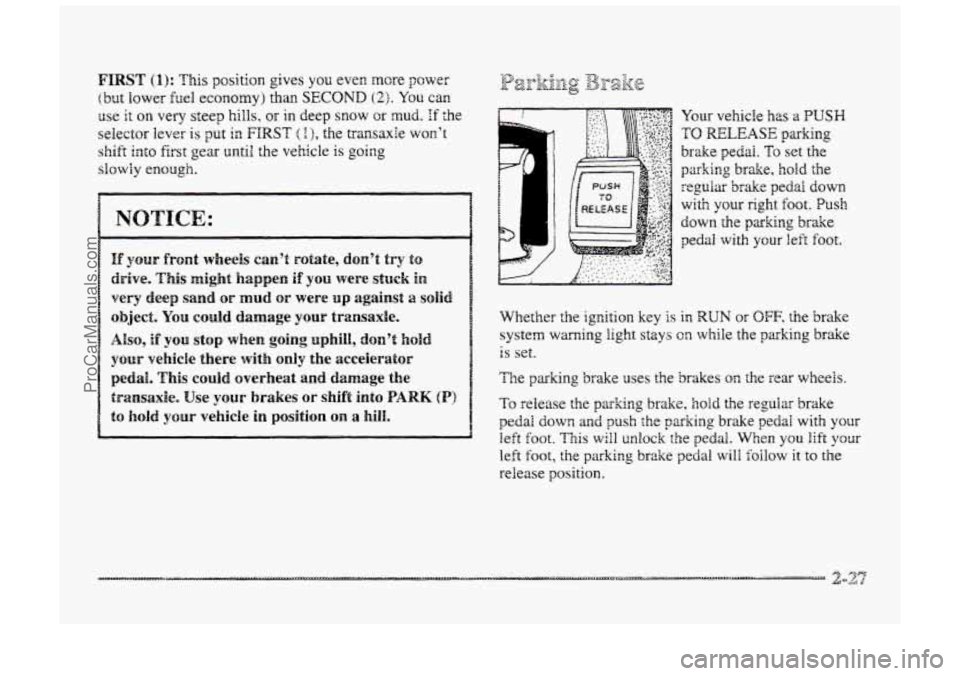
FIRST (I): This position gives you even more power
(but lower fuel economy) than SECOND (2). You can
use it on very steep hills, or in deep snow or mud. If the
selector lever is put in FIRST ( I >, the transaxle won’t
shift into first gear until the vehicle is going
slowHy enough.
If your hplrt wheels can’t rotate, don’t try to
drive. This might happen if YOU were stuck in
very deep sand OF mud or were up against a solid
object. You could damage your transaxle.
Also, if you stop when going uphill, don’t hold
your vehicIe there with only the accelerator
pedal. This could overheat and damage the
transaxle. Use ysur brakes or shift into BARK (P)
Your vehicle has a PUSH
TO RELEASE parking
brake pedai. To set the
parking brake, hold the
regular brake pedal down
with your right foot. Push
down the papking brake
pedal with your left foot.
~~ ~~
Whether the ignition key is in RUN or OFF. the brake
system
wming light stays on while the parking brake
1s set.
The parhng brake uses the brakes the rear wheels.
To release the parking brake, hoki the regular brake
pedal down and push the parking brake pedal with your
left foot. This will unlock the pedal. When you lift your
left foot, the parking brzke pedal will foilow it to the
release position.
ProCarManuals.com
Page 94 of 426
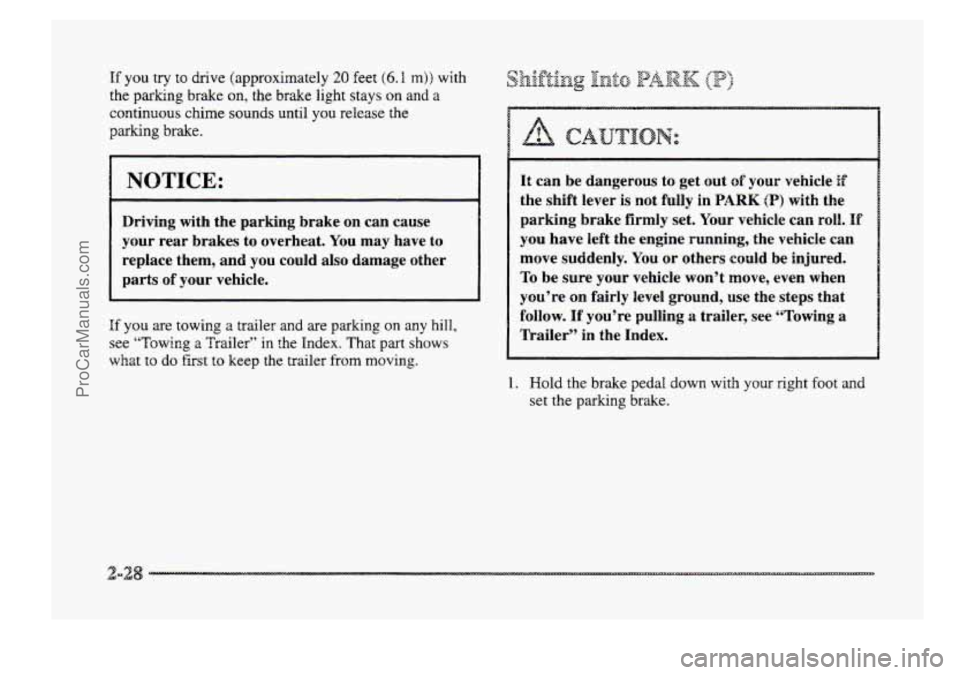
If you try to drive (approximately 20 feet (6.9 m)) with
the
parlkrng brake on, the brake light stays on and a
continuous chime sounds until you release the
parking
brake.
NOTICE:
Driving with the parking brake on can cause
your rear brakes to overheat. You may have to
replace them, and you could also damage other
parts
of your vehicle.
If you are towing a trailer and are parking on any hill,
see “Towing a Trailer” in the Index. That part shows
what
to do first to keep the trailer from moving.
It can be dangerous to get out of your vehicle if
the shift lever is not fully in PARK (P) with the
parking brake firmly set. Your vehicle can roll.
If
you have left the engine running, the vehicle can
move suddenly. You or others
could be injured.
To be sure your vehicle won’t move, even when
you’re on fairly level ground,
use the steps that
follow.
If you’re pulling a trailer, see “Towing a
Trailer” in the Index.
1. Hold the brake pedal down with your right foot and
set the parking brake.
ProCarManuals.com
Page 96 of 426

~ It can be dangerous to leave YQW vehicle with the
~ engine running. Your vehicle could move
i suddenly if the
shift lever is not hlPy in PARK (P)
with the parking brake firmly set. And, if you
leave the vehicle with the engine running, it couk.€
overheat and even catch fire. YQU or others could
be injured. Don’t leave YOUK- vehicle with the
engine running unless you have to.
I
Hf you have to leave your vehicle with the engine
running, be sure your vehick is in PARK (P) and your
parking brake is firmly set before you Ieave it. After
you’ve moved the shift lever into the ?ARK (P)
position, hold the regular brake pedal down. Then, see if
YOU can move the shift lever away from PARK (?)
without first pulling it toward you. If you can, it means
that the shift lever wasn’t fully locked into PARK (P).
r-m naqae Le!#& I
If you are parking on ;I hill and you don’t shift your
transaxle into PAKM (P) properly, the weight of the
vehicle may put too rntich force OD the parking pawl in
the transaxle. You may f’ind it difficult to pull the shift
lever out of PARK (P). This is called “torque lock.” To
prevent torque lock, set the parking brake and then shift
into PARK (P) pr~perfy before you leave the driver’s
seat.
TQ find out how, see “Shifting Into PARK (P)” in
the Index.
When you are ready to drive, move the shift lever out of
PARK (P) bejbre YOU retease the parking brake.
If torque lock does occur, you may need to have another
vehicle
push yours a little uphill to take some of the
pressure from the pxking pawl in the tramaxle, so you
can pull, the shiR lever out of PARK (P).
ProCarManuals.com
Page 99 of 426
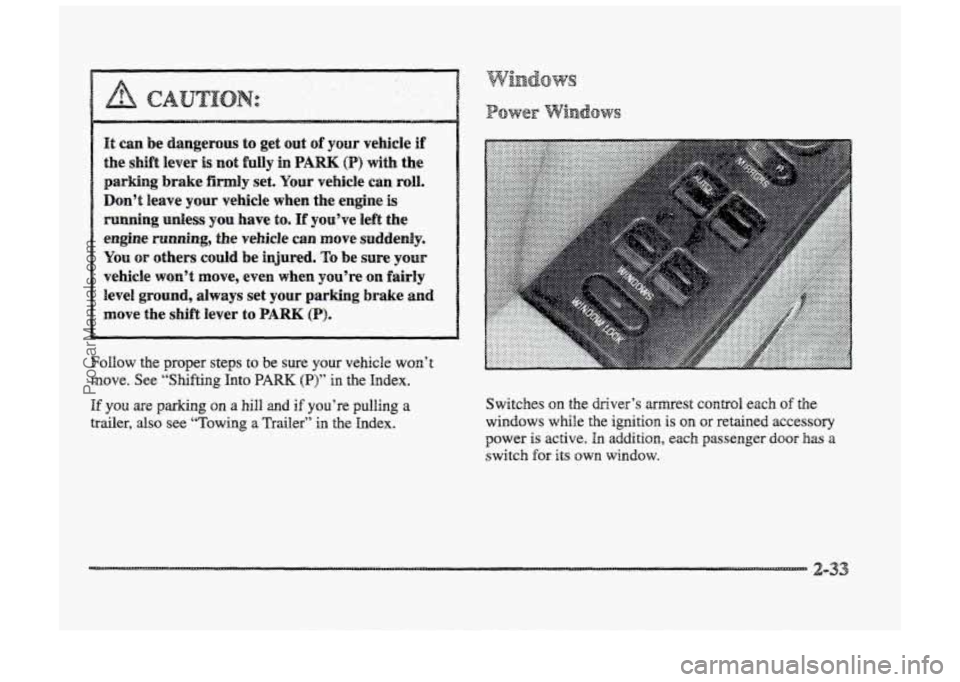
I& can be dangerous to get ut of your vehicle if
the shift lever is not fully in PARK (PI with the
parking brake firmly set. Your vehicle can roll.
Don’t leave your vehicle when the engine is
running unless you have to. If you’ve left the
engine mnnhg, the vehicle can BP~QV~ suddenly.
You or others could be injured. To be sure YOW
vehicle won’t move, even when you’re OEI fairly
level ground, always set your parking brake and
move the shift lever to PARK (PI.
H701Iow the proper steps to be sure your vehicle won’t
move. See “Shifting Into PARK (P)” in the Index.
If YOU are parking on a hill and if you’re pulling a
trailer, also see “Towing a Trailer” in the Index. Switches
on the driver’s
mest conltrol.each of the
windows while the
ignition is on or retained accessory
power
is active. In addition, each passenger door has a
switch for its own window.
2-33
ProCarManuals.com
Page 243 of 426

1. Check the other vehicle. It must have a 12-volt
battery with a negative ground system.
2. Get the vehicles close enough so the jumper cables
can reach, but be sure the vehicles aren’t touching
each other.
If they are, it could cause a ground
connection YOU don’t want. YQU wouldn’t be able to
start your vehicle, and the bad grounding could
damage
the electrical systems.
TQ avoid the possibility of the vehicles rolling, set
the parking brake firmly on both vehicles involved.
Put
an automatic transaxle in PARK (PI before
setting the parking brake.
ProCarManuals.com
Page 248 of 426
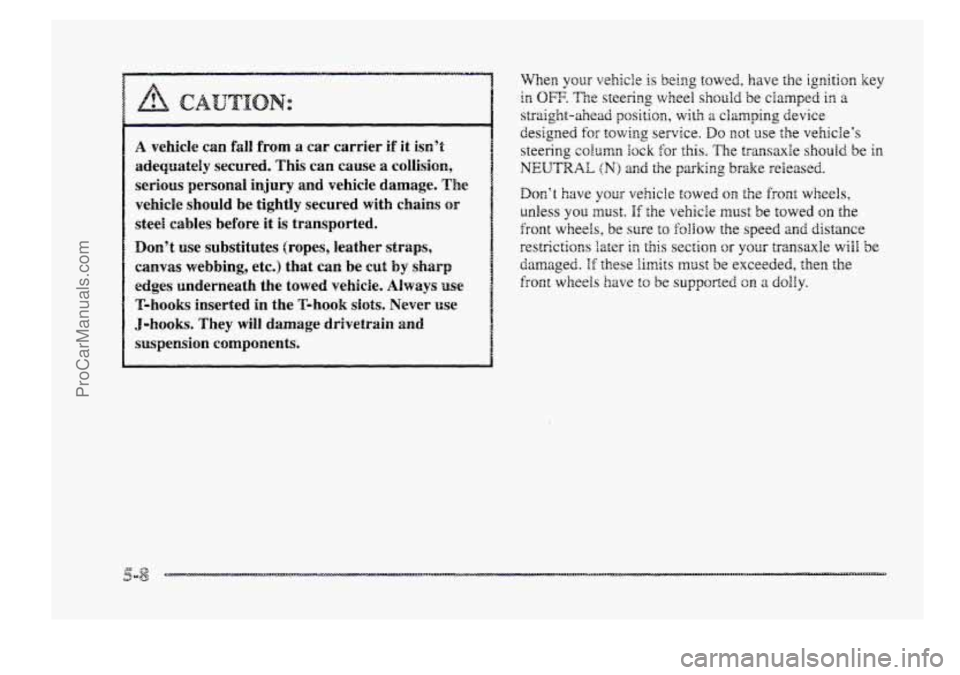
2
A vehicle can fall from a car carrier if it isn’t
adequately secured. This can cause a collision,
serious personal injury and vehicle damage. The
vehicle should be tightly secured with chains OF
steel cables before it is transported.
Don’t use substitutes (ropes, leather straps,
canvas webbing, etc.) that can be cut by sharp
edges underneath the towed vehicje. Always use
T-hooks inserted in the T-hook siob. Never use
J-hooks. They will damage drivetrain and
suspension components. When your vehicle
is being towed, have the ignition key
in OW. The steering wheel should be
clamped in a.
straight-ahead position, with a clamping device
designed for towing service. DQ not use the vehicle’s
steering
column iock for this. The transaxle should be in
NEUTRAL (N) and the parking brake released.
Don’t have your vehicle towed the front wheels,
unless you must. If the vehicle must be towed QII the
front wheels, be sure to fallow the speed and distance
restrictions later in this section or your transaxle will be
damaged. If these Limits must be exceeded, then the
front wheels have to be supported on a dolly.
ProCarManuals.com
Page 357 of 426
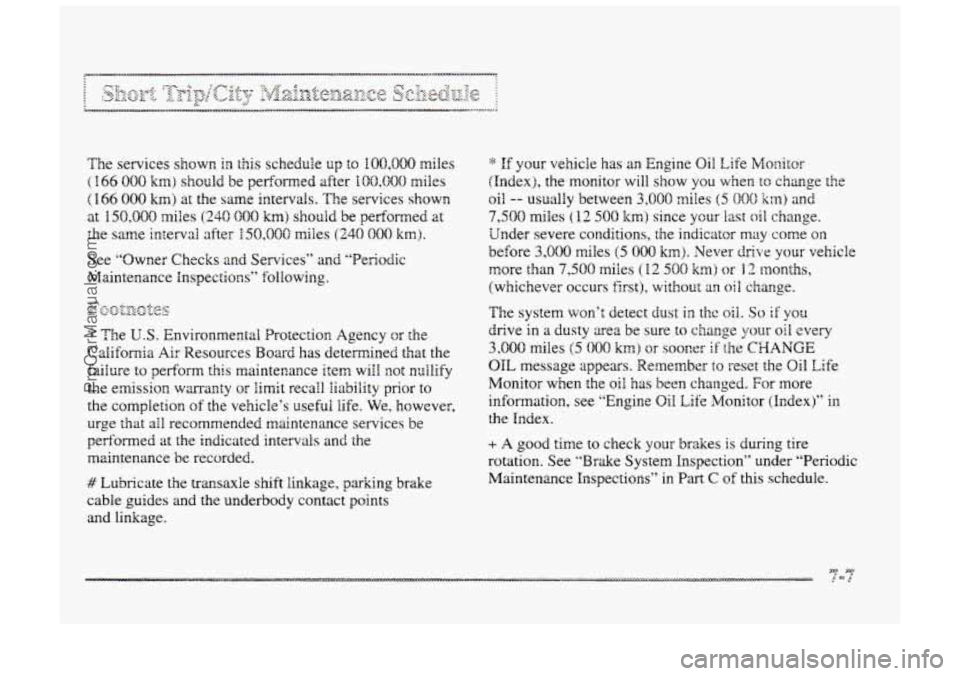
m. B he services shown in this schedule up to IOO,QQ0 miles
( 166 000 am) should be performed after 100,800 miles
( I. 66 008 km) at the same intervals. The services shown
at 150,000 miles (240 GOO km) shouid be performed at
the same interval after
150,000 riles (240 000 km).
See “Owner Checks and Services” md “Periodic
Maintenance inspections” following.
* The U.S. Environmental Protection Agency or the
California Air Resources
Boxd has determined that the
failure
to perform this maintenance item will not nuIli€y
the elmission wmanty or
limit recall liability prior to
the completion
of the vehicle’s useful life. We, however,
urge
that ail recommended maintenance services be
performed at the indicated intervals
and the
maintenance be recorded.
# Lubricate the transaxle shift linkage, parking brake
cable guides and the underbody contact points
and
linkage.
* If your vehicle has an Engine Oil Life Monitor
(Index), the monitor will show you when to change the
oil
-- usually between 3,000 miles (5 CIOC) kn) and
7,500 miles ( 12 500 lmj since your last oil change.
Under severe conditions, the indicator may come on
before 3,000 wiles (5 000 h). Never drive your vehicle
more than
7,500 miles (12 508 am> or i 2 months,
(whichever occurs first), without an oil change.
Tne
system won‘: detect dust in thc oil. So if you
drive in a dusty area be sure to change pur oil every
3,000 miles (5 008 km) or sooner if: the CHANGE
OIL message appears. Remember to reset the Oil Life
‘Monitor
when the oil has been changed. For more
information, see “Engine
Oil Life ,Monitor (Index)” in
the Index.
+ A good time to check your brakes is during tire
rotation. See
“Brake System Inspection” under “Periodic
Maintenance Inspections” in
Part C of this schedule.
ProCarManuals.com
Page 372 of 426
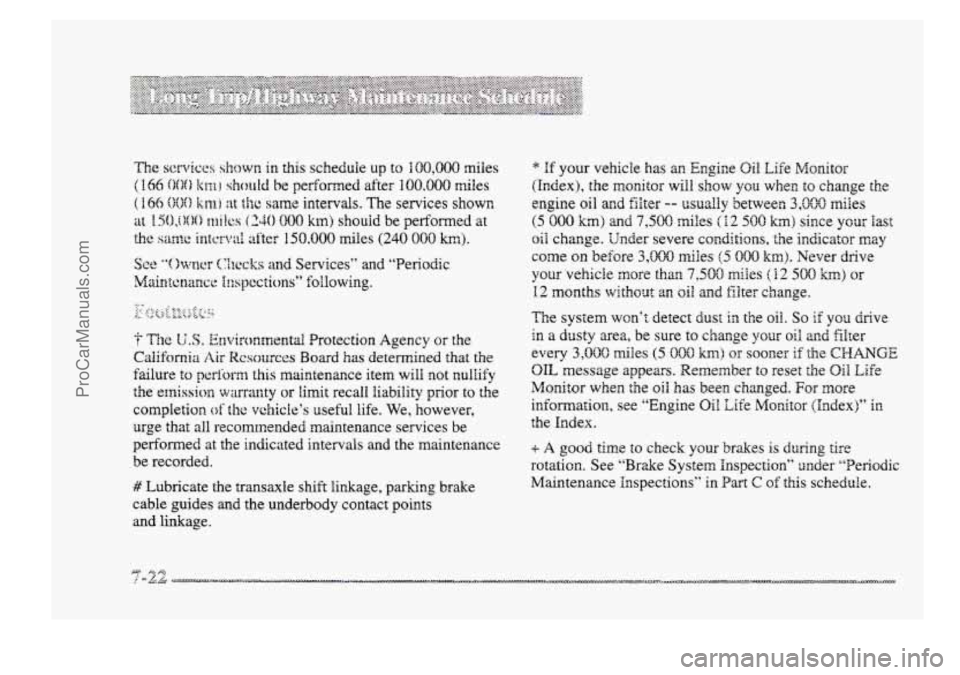
? The U.S. E~wironrnentd Protection Agency the
Cainiifomire Air R!csources Board has determined that the
failure
to pertc)rm this maintenance item will not nullify
the
emission warranty or limit recall liability prior to the
completion
or‘ the vehicle’s useful life. We, however,
urge
that all recommended maintenance services be
performed
at the indicated intervals and the maintenance
be recorded.
## Lubricate the transaxle shift linkage, parking brake
cable guides and the underbody contact points
and linkage.
* If your vehicle has m Engice Oil Life Monitor
(Index), the monitor will show you when to change the
engine
oil and filter -- usually between 3,000 miles
(5 GOO km> and 7,500 miles (X2 500 krn) since your last
oil change. Under severe conditions. the indicator may
come on before 3,008 miles (5 8064 km). Never drive
your vehicle more than 7,500 miles ( 12 500 km) or
12 months without an oil and filter change.
The system won’t detect
dust in the oil. So if yo2 drive
in a dusty area, be sure to change your oil. and filter
every 3,000 miles (5 000 km) ~r sooner if thms CHANGE
OIL message appears. Remember to reset the Oil Life
Monitor when the oil has been changed. For more
information,
see “Engine Oil Life Monitor (Index)” in
the Index.
+- A good time to check your brakes is during tire
rotation. See “Brake System Inspection” under “Periodic
Maintenance Inspections”
in Part C of this schedule.
ProCarManuals.com